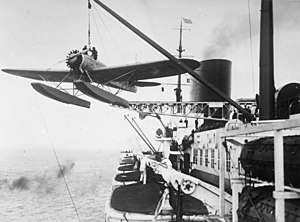Heinkel HE 58
| Heinkel HE 58 | |
|---|---|
 HE 58 D-1919 Bremen is lifted onto the catapult of Europa |
|
| Type: | single-engine catapult aircraft |
| Design country: | |
| Manufacturer: | |
| Commissioning: |
1930 |
| Number of pieces: |
1 |
The Heinkel HE 58 was a catapult airplane with floats built in 1930 in the German Reich . It was specially designed for use on the express steamer Europa , from which it could be launched with a catapult on the Atlantic to bring mail from the ship ashore early. The abbreviation “HE” stands for “Heinkel monoplane” and is not to be confused with the “He” factory identifier assigned by the RLM in 1932 .
history
The North German Lloyd (NDL) already had a 1927 Junkers F-13 -Schwimmerflugzeug on the steamer Lutzow carried to the passengers in port calls to offer sightseeing flights. The management of the NDL recognized that a float plane on board a high-speed steamer opened up additional income opportunities, since this transport would bring the mail from the high-speed steamer to land much earlier at greater distances from the destination port. As a result, the Heinkel company began to construct a catapult and the NDL planned to use catapults and aircraft for mail transport on its new express steamers Bremen and Europa . The Lufthansa agreed to provide operational support to the project. When the Bremen set out on her maiden voyage in 1929, she had the Heinkel HE 12 D-1717 on board.
construction
The only Heinkel HE 58 D-1919 was a further development of the HE 12 developed for Bremen . She was a conventionally braced low-wing aircraft. The structure was made of wood with fabric covering, the wider fuselage consisted of a welded tubular steel frame covered with fabric. The top of the fuselage to behind the seats was planked with light metal sheet, as was the engine front end. Unlike in the HE 12 , the pilot and radio operator sat next to each other in an open cockpit and the post office was in a cargo hold behind them. The engine was later disguised.
Calls
In contrast to the sister ship Bremen , the Heinkel HE 58 was only used by Europa for the first time after the ship had made several trips and acquired the Blue Ribbon . On August 28, 1930, the HE 58 D-1919 “Atlantic” took off 120 km from New York for a first test flight without mail under Jobst von Studnitz and Karl Kirchhoff, which in July 1929 also made the first flight from the Bremen with the similar HE 12 had carried out. On the return journey, too, the flight started 900 km from Amsterdam without a post. There were then four mail flights by the end of the season.
In 1931, the aircraft, renamed “Bremen”, carried out 15 post flights in the season from May 16 to October 3. Only the flight to New York planned for June 17th had to be canceled due to a defect. On September 8, the machine was catapulted for the first time 2487 km from New York, in order to reach its destination in a night flight after a stopover for refueling in Sydney (Nova Scotia) and several hours of rest. The last mail flight of the year from Europa on October 3rd started 1,100 km from Southampton and continued for another 1,100 km to Travemünde the following day. From there, the machine was overhauled and taken to the winter storage facility in Warnemünde. The pilot in the season was Joachim Blankenburg, who with over 100 Atlantic flights became the most successful Atlantic pilot of the old Lufthansa. He was accompanied by Karl Kirchhoff as a radio machinist, with 84 flights the second most frequently used Atlantic plane for Lufthansa. Both were killed in a plane crash in 1938. Kirchhoff when a Heinkel He 116 crashed off Langeoog, Blankenburg in a Junkers Ju 90 over Bathurst.
Between May 19 and October 5, 1932, the machine - moved to Bremen - was used for 18 mail advance flights. Only the flight on August 1st to Southampton had to be canceled due to an engine failure; the machine returned to the Bremen . With 40 pre-excursions by post, the Heinkel HE 58 completed the most catapult flights. Whether and how the machine was used from 1933 is unknown.
replacement
The Europa received a new Junkers Ju 46 aircraft as early as 1932 , the Bremen followed in 1933. This type remained in service until the end of the catapult flights in 1935.
Technical specifications
| Parameter | HE 12 | HE 58 |
|---|---|---|
| crew | 2 (pilot and radio operator) | |
| length | 11.56 m | 11.73 m |
| span | 16.80 m | 17.20 m |
| height | 4.55 m | 4.685 m |
| Wing area | 48.46 m² | 49.40 m² |
| payload | 200 kg mail | 200 kg mail? |
| Empty mass | 1580 kg | 1850 kg |
| Takeoff mass | 2600 kg | 3140 kg |
| Top speed | 216 km / h | 204 km / h |
| Cruising speed | 180 km / h | 175 km / h |
| Range | approx. 1600 km | |
| Engine | a 9-cylinder radial engine Pratt & Whitney Hornet A with 450 hp | |
literature
- Jörg-M. Hormann: Flugbuch Atlantik, German catapult flights 1927–1939 . Delius Klasing Verlag, 2007, ISBN 3-7688-1973-6 .
- H. Dieter Köhler: Ernst Heinkel - pioneer of high-speed aircraft . Bernard & Graefe, 1983.
Web links
Individual evidence
- ↑ picture of HE 58 Bremen (accessed on March 2, 2018)
